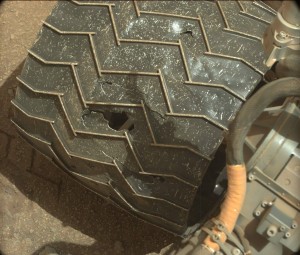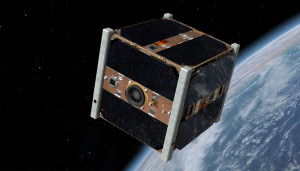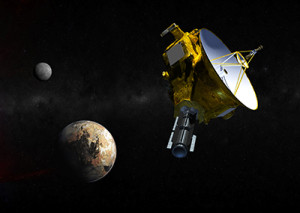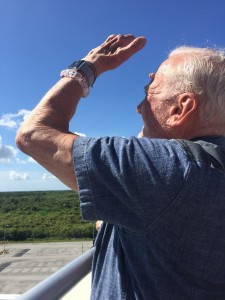Archive for July, 2015
NASA’s Curiosity Mars rover faces on-going wheel wear and tear as it continues its trek across the sandy and rock strewn Red Planet.
The car-sized Mars machinery has been on duty since landing on the planet in August 2012. Curiosity has six aluminum wheels, each with its own individual motor. The rover has a top speed on flat hard ground of a little over 1.5 inches (4 centimeters) per second.
But dealing with the rocky richness of martian landscape has become somewhat of an unanticipated wheel of misfortune.

NASA’s Mars rover Curiosity acquired this image using its Mars Hand Lens Imager (MAHLI) on July 5, 2015, Sol 1035 of the Mars Science Laboratory Mission.
Credit: NASA/JPL-Caltech/MSSS
Back here on Earth, Mars Science Laboratory engineers are watching the wheels turn, keeping an eye on cracks and the length of cracks.
Go to my new Space.com story for the “hole” story at:
Wheel Worries: Mars Rover Curiosity Dealing With Damage
by Leonard David, Space.com’s Space Insider Columnist
July 06, 2015 02:00pm ET
http://www.space.com/29844-mars-rover-curiosity-wheel-damage.html
A team of engineers has been at work for the past three years to develop a space cleanup satellite. The intent is to eliminate threatening, human-made orbital debris.
The worry is not new – there’s lots of clutter to pick and choose from, be it broken down satellites to tossed away rocket stages.
A new entry to de-litter Earth orbit is the Clean Space One Project, spearheaded by researchers from eSpace, Ecole Polytechnique Fédérale de Lausanne’s (EPFL) Center for Space Engineering and Signal Processing 5 Laboratory and HES-SO University of Applied Sciences and Arts Western Switzerland.
Their intent is to trap a small satellite – SwissCube – tossed into space in late 2009. SwissCube is a joint CubeSat project of various laboratories at EPFL and universities in Switzerland.
Sizing up the situation
This small CubeSat-type satellite, measures just 10 centimeters by 10 centimeters. Barring an unforeseen event, SwissCube’s demise has been programmed for 2018.
The size of SwissCube makes it tough to grasp, but it also has darker and lighter parts that reflect sunlight differently, explains Christophe Paccolat, a PhD student working on the concept.
CleanSpace One could be launched as early as 2018 in collaboration with the company S3, headquartered in Payerne.
“Net” working
The engineering team is reporting a major step forward in designing an approach and capture system – a so-called “Pac-Man” solution.
The prototype CleanSpaceOne resembles a net in the form of a cone that unfolds and then closes back down once it has captured the small satellite. It will trap the small satellite and the two would combust together in the atmosphere.
Other work on the initiative involves creating and testing visual approach algorithms on the cleanup satellite’s cameras.
To be accurate, they must take into account a variety of parameters, a team press statement notes, such as the angle of illumination of the Sun and the relative speed at which the CubeSat is moving through space.
Larger margin
Muriel Richard-Noca, head of the project, emphasizes the extreme delicacy of the mission: “It only takes one error in the calculation of the approach for SwissCube to bounce off CleanSpace One and rocket out into space.”
Adds Michel Lauria, a professor of industrial technology at Hepia Lab in Geneva: “This system is more reliable and offers a larger margin for maneuvering than a claw or an articulated hand.”
The next stage of work involves fabricating a more true-to-life engineering model – which will be more accurate than the prototypes – and more extensive testing.
Take a look at this team’s approach to gobble up space debris by going to:
https://www.youtube.com/watch?v=pclqbhRKkdM
Update: New Horizons Plans July 7 Return to Normal Science Operations…
NASA’s New Horizons mission is returning to normal science operations after a July 4 anomaly and remains on track for its July 14 flyby of Pluto.
The investigation into the anomaly that caused New Horizons to enter “safe mode” on July 4 has concluded that no hardware or software fault occurred on the spacecraft.
The underlying cause of the incident was a hard-to-detect timing flaw in the spacecraft command sequence that occurred during an operation to prepare for the close flyby. No similar operations are planned for the remainder of the Pluto encounter.
Closing in on its prey NASA’s New Horizons spacecraft en route to Pluto experienced an anomaly on U.S. Independence Day – July 4th.
The glitch led to a loss of communication with Earth. However, communication has since been reestablished and the spacecraft is healthy.
According to a NASA statement: The autonomous autopilot on board the spacecraft “recognized a problem” and – as it’s programmed to do in such a situation – switched from the main to the backup computer.
The autopilot placed the spacecraft in “safe mode,” and commanded the backup computer to reinitiate communication with Earth. New Horizons then began to transmit telemetry to help engineers diagnose the problem.
The glitch lasted from 1:54 p.m. EDT to 3:15 p.m. EDT when communications were regained.
A New Horizons Anomaly Review Board (ARB) was convened to identify the problem.
Work is underway to return New Horizons to its original flight plan.

Pluto and Charon surfaces in living color.
Credit: NASA/Johns Hopkins University Applied Physics Laboratory/Southwest Research Institute
Due to the 9-hour, round trip communication delay that results from operating a spacecraft almost 3 billion miles (4.9 billion kilometers) from Earth, full recovery is expected to take from one to several days.
During this time, New Horizons will be temporarily unable to collect science data.
Go to this new movie of motion!

NASA’s Curiosity Mars rover is examining a valley where at least two types of bedrock meet, for clues about changes in ancient environmental conditions recorded by the rock.
Credit: NASA/JPL-Caltech/MSSS
NASA’s Curiosity Mars rover is examing a zone where two regional rock units neighbor each other near “Marias Pass.”
The rover is inspecting an area where at least two types of bedrock meet, finding pale mudstone and darker, finely bedded sandstone.
Story-telling rock
According to the Jet Propulsion Laboratory’s Curiosity website: “On Mars as on Earth, each layer of a sedimentary rock tells a story about the environment in which it was formed and modified. Contacts between adjacent layers hold particular interest as sites where changes in environmental conditions may be studied. Some contacts show smooth transitions; others are abrupt.”
This site of mudstone and sandstone also includes a thin band of coarser-grained rock that’s different from either of these materials.

NASA’s Mars rover Curiosity acquired this image using its Mars Hand Lens Imager (MAHLI), located on the turret at the end of the rover’s robotic arm, on July 2, 2015, Sol 1032.
Credit: NASA/JPL-Caltech/MSSS
Full operation
In late May, Curiosity climbed an incline of up to 21 degrees to reach Marias Pass, guided by images from NASA’s Mars Reconnaissance Orbiter.
Curiosity’s international team of researchers has resumed full operations of the car-size mobile laboratory after a period of limited activity during most of June.

Credit: NASA, ESA, D. Calzetti (University of Massachusetts), H. Ford (Johns Hopkins University), and the Hubble Heritage (STScI/AURA)-ESA/Hubble Collaboration
The author of a new study of evolutionary convergence argues that the development of life on Earth is predictable, meaning that similar organisms should therefore have appeared on other, Earth-like planets by now.
“The almost-certainty of ET being out there means that something does not add up, and badly. We should not be alone, but we are.”
That’s the view of leading evolutionary biologist, Simon Conway Morris, a Fellow at St John’s College, University of Cambridge in Cambridge, England. That outlook and others are carried in his new book The Runes of Evolution – How the Universe Became Self-Aware.
Rigid set of rules
Extra-terrestrials that resemble humans should have evolved on other, Earth-like planets, making it increasingly paradoxical that we still appear to be alone in the universe, Conway Morris suggests.
According to a University of Cambridge press statement, the book claims that evolution is far from random, but a predictable process that operates according to a fairly rigid set of rules.
“If that is the case, then it follows that life similar to that on Earth would also develop in the right conditions on other, equivalent planets. Given the growing number of Earth-like planets of which astronomers are now aware, it is increasingly extraordinary that aliens that look and behave something like us have not been found,” Conway Morris contends.
Inevitable consequence
Conway Morris has previously raised the prospect that alien life, if out there, would resemble earthlings – with limbs, heads, and bodies. In his new book, he adds that any Earth-like planet should also evolve thunniform predators (like sharks), pitcher plants, mangroves, and mushrooms, among many other things.
Limbs, brains and intelligence would, similarly, be “almost guaranteed.” The traits of human-like intelligence have evolved in other species – the octopus and some birds, for example, both exhibit social playfulness – and this, Conway Morris observes, indicates that intelligence is an inevitable consequence of evolution that would characterize extraterrestrials as well.
Perplexing issue
“The number of Earth-like planets seems to be far greater than was thought possible even a few years ago,” Conway Morris notes. “That doesn’t necessarily mean that they have life, because we don’t necessarily understand how life originates. The consensus offered by convergence, however, is that life is going to evolve wherever it can.”
Conway Morris adds: “I would argue that in any habitable zone that doesn’t boil or freeze, intelligent life is going to emerge, because intelligence is convergent. One can say with reasonable confidence that the likelihood of something analogous to a human evolving is really pretty high. And given the number of potential planets that we now have good reason to think exist, even if the dice only come up the right way every one in 100 throws, that still leads to a very large number of intelligences scattered around, that are likely to be similar to us.”
If this is so, as the book suggests, then it makes Enrico Fermi’s famous paradox – why, if aliens exist, we have not yet been contacted – even more perplexing.
Resources
The Runes of Evolution, by Simon Conway Morris, is published by Templeton Press at:
https://www.templetonpress.org/book/runes-evolution
Also, go to this Cambridge University press release:
http://www.cam.ac.uk/research/news/map-of-life-predicts-et-so-where-is-he
Check out this Map of Life website at:
The recent failure of the commercial SpaceX Falcon 9 rocket is a near-term setback. But getting that vehicle back in the air means something more for the tomorrows to come. It means getting down to business concerning the future of America’s space program.
Buzz Aldrin, Gemini and Apollo space mission veteran, was witness to the Falcon 9’s failed flight on June 28. Sitting there at the Kennedy Space Center in Florida he had a front row seat to the mishap.
His views regarding the loss and how it impacts the future of space commercialization are revealed in this just-released TIME op ed.
Go to:
http://time.com/3945033/buzz-aldrin-spacex-commercial-space-travel/

A SpaceX Falcon 9 rocket lifts off from Space Launch Complex 40 at Cape Canaveral Air Force Station. The Falcon 9 launched on time at 10:21 a.m. EST. After liftoff, an anomaly occurred. SpaceX is evaluating the issue.
Credit: NASA
Here’s a new story from me on the recent loss of the SpaceX Falcon 9 booster:
The June 28 failure of the commercial SpaceX Falcon 9 has put a dent in the rocket’s impressive track record. Whatever the root cause of the malfunction, fixing the problem, and returning to flight is paramount to fulfill billions of dollars launch orders.
There are a number of wait-and-watch ripple effects stemming from the booster catastrophe that are being flagged by space analysts I contacted:
How Will Sunday’s Rocket Explosion Affect SpaceX?
by Leonard David, Space.com’s Space Insider Columnist
July 01, 2015 11:05am ET
http://www.space.com/29822-spacex-rocket-failure-impact.html
Note: During a post-launch press conference on June 28, mangers from SpaceX, NASA, and the Federal Aviation Administration discussed the mishap following the liftoff of the SpaceX CRS-7 mission from Space Launch Complex 40 at Cape Canaveral Air Force Station. The mission was to deliver supplies, hardware and other important cargo to the International Space Station.
Hans Koenigsmann, vice president of Mission Assurance at SpaceX, is leading the investigation of the cause of the issue.
Participants in the news briefing were:
— Gwynne Shotwell, president and chief operating officer of SpaceX (via phone)
— Bill Gerstenmaier, associate administrator of NASA’s Human Exploration and Operations Mission Directorate (via video from NASA Headquarters)
— Michael Suffredini, NASA’s International Space Station Program manager
— Pam Underwood, deputy division manager, Operations Integration Division, Federal Aviation Administrator.
To view the video, go to:
http://www.nasa.gov/feature/video-nasa-spacex-faa-discuss-launch-failure
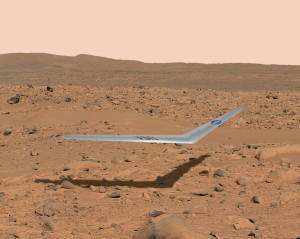
Illustration shows what a Prandtl-m might look like flying above the surface of Mars.
Credits: NASA Illustration / Dennis Calaba
A flying wing may be added to the tool kit for future exploration of the Red Planet.
An early design of such a craft is called the Preliminary Research Aerodynamic Design to Land on Mars, or Prandtl-m.
The concept, quite literally, is under the wing of a research group at NASA’s Armstrong Flight Research Center (AFRC) at Edwards, California.
Prandtl-m is planned to be ready for launch from a high altitude balloon later this year.
The craft would be released at about at 100,000 feet altitude, a sky-high zone that simulates the flight conditions of the Martian atmosphere, said Al Bowers, NASA Armstrong chief scientist and Prandtl-m program manager.
CubeSat deployed
Tests here on Earth are validating how the aircraft works, leading to modifications that will allow it to fold and deploy from a 3U CubeSat in the aeroshell of a future Mars-bound rover.
There is the prospect that the CubeSat could find its way onboard the aeroshell/Mars rover piggyback stack for Red Planet exploration in 2022-2024.
Once deployed from the CubeSat, Bowers said that Prandtl-m would stretch its wings and fly in the Martian atmosphere, gliding down and coming to full stop atop the Martian landscape.
“It would have a flight time of right around 10 minutes. The aircraft would be gliding for the last 2,000 feet to the surface of Mars and have a range of about 20 miles,” Bowers said. The aircraft’s wingspan, when deployed, would measure 24 inches and weigh less than a pound, he said.
Landing site verification
The Prandtl-m could zoom over some of the proposed landing sites for a future crewed Mars mission, Bowers said, “and send back to Earth very detailed high resolution photographic map images that could tell scientists about the suitability of those landing sites,” Bowers noted in an AFRC press release.
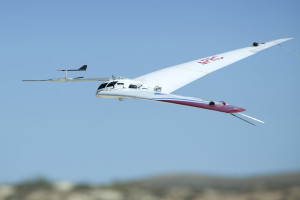
Air time on Earth. The proposed Prandtl-m — “m” for Mars — is based on the Prandtl-d seen coming in for a landing during a flight test in June. The aerodynamics offer a solution that could lead to the first aircraft on Mars.
Credits: NASA Photo / Ken Ulbrich
The Flight Opportunities Program, which is managed at NASA Armstrong, has agreed to fund two balloon flights during the next several years and potentially a sounding rocket flight following that to demonstrate how the flier would work on Mars, Bowers said.
Sounding rocket test
Riding on a sounding rocket, the prototype Mars wing, packed inside a CubeSat, would be released at 450,000 feet.
Falling back into the Earth’s atmosphere as it approaches the 110,000-to-115,000-feet altitude range, the glider would deploy just as though it was over the surface of Mars.
“If the Prandtl-m completes a 450,000-foot drop, then I think the project stands a very good chance of being able to go to NASA Headquarters and say we would like permission to ride to Mars with one of the rovers,” Bowers said.
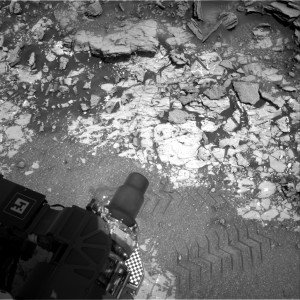
NASA’s Curiosity Mars rover is eyeing “Missoula” – a target that’s a ledge in the upper left portion of this Navcam image.
Credit: NASA/JPL-Caltech
NASA’s Curiosity Mars rover is busy imaging a number of targets – one of which is called “Missoula.”
“We refer to it as a dog’s eye mosaic, meaning that we use the MAHLI camera to take a series of images along a vertical face – essentially sticking our nose in there to get a good view,” Edgar explains.
The Mars Hand Lens Imager (MAHLI) is located on the turret at the end of the rover’s robotic arm.
Edgar says that the current plan for rover duties also includes several ChemCam observations along such targets as “Selow” and “Clark.”
Doing so would characterize any changes in chemistry from two geological units: the Pahrump unit into the Stimson unit, Edgar adds.
Another ChemCam assessment is focused on the target “Seeley” – a broken rock that exposes a fresh surface.

Mars Hand Lens Imager (MAHLI) image taken on June 28, Sol 1028. MAHLI is located on the turret at the end of the rover’s robotic arm.
Credit: NASA/JPL-Caltech/MSSS
Lastly, a Mastcam mosaic is to capture some of the surrounding mineral veins that Curiosity is exploring.
Planning is underway for working the rover during its Sol 1032.
